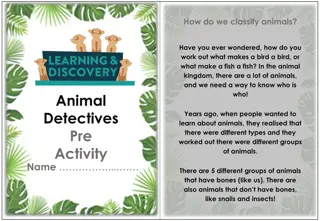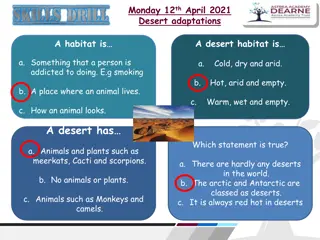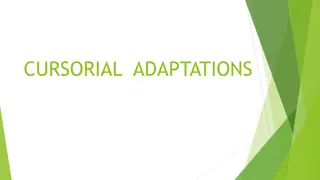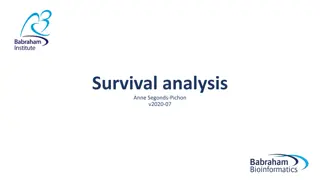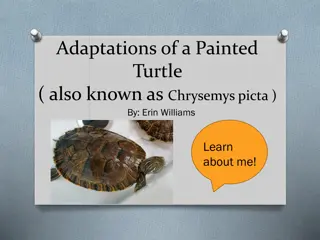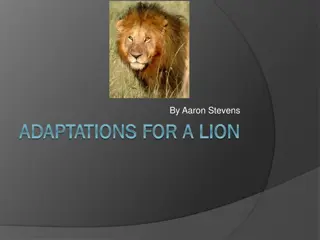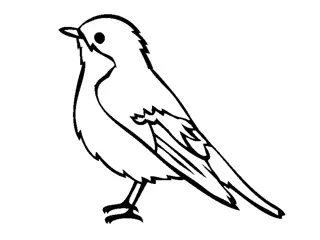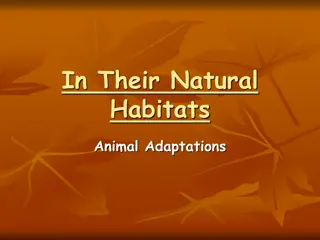Birds: Adaptations of Beaks and Feet for Survival
Explore the fascinating world of bird adaptations through the modification of beaks and feet. From tearing and piercing beaks to fruit-eating beaks, mud-probing beaks, fish-catching beaks, and wood chiselling beaks, discover how different bird species have evolved unique features to thrive in their environments. Stunning images accompany detailed descriptions of various bird beak and feet adaptations, showcasing the diversity and ingenuity of nature's creations.
Download Presentation

Please find below an Image/Link to download the presentation.
The content on the website is provided AS IS for your information and personal use only. It may not be sold, licensed, or shared on other websites without obtaining consent from the author.If you encounter any issues during the download, it is possible that the publisher has removed the file from their server.
You are allowed to download the files provided on this website for personal or commercial use, subject to the condition that they are used lawfully. All files are the property of their respective owners.
The content on the website is provided AS IS for your information and personal use only. It may not be sold, licensed, or shared on other websites without obtaining consent from the author.
E N D
Presentation Transcript
Practical No.17 2 To Study Of Modification Of Beaks And Feet In Birds. A) Beak- Tearing And Piercing, Fruit Eating, Mud Probing, Fish Catching, Wood Chiselling And Flower Probing B) Feet- Perching, Raptorial, Climbing, Swimming, Running
3 Modification Of Beaks In Birds.
Tearing And Piercing Beak 4 The carnivorous birds which feed on carrion and flesh, have short, pointed sharp- edges, powerful, hooked beak for tearing flesh. These beak operated by well developed mandibular muscles. E.g. Eagle, Owls, Kites, Hawks, Vultures, etc.
5 Eagle Kite Owl Vulture Hawk
Fruit Eating Beak 6 Many Birds feed on fruits hence their beak is adapted for breaking hard fruits, Nuts, hard seeds. In case of Parrot beak is very sharp, massive and deeply hooked and extremely strong. It is useful for Gnawing or breaking open hard seeds and Nuts. The Beak of Hornbill is very large, enormous, heavy and cubersome. E.g. Parrot, Hornbill, etc.
7 Parrot Hornbill
Mud Probing Beak 8 This type of Beaks are very long, Slender and Slightly curved. These are used as probes for thrusting in the mud searching the food which usually aquatic Worms and Larvae. These are commonly found in Stilts, Sand-pipers, Jacanas, Curlews, etc.
9 Stilt Sand- Piper Jacana Curlew
Fish Catching Beak 10 The fish catching Beak is long, Narrow and Sharp. In Cormorant the beak is slightly curved at the tip and have tooth- like processes adapted for capturing the fish. In Kingfisher the beak is long powerful and sharply pointed to capture fish, frogs, Tadpoles, Molluscs and other aquatic animals. E.g. Herons, Kingfisher, Cormorants, Indian darter OR Snakebirds, etc.
11 Heron Kingfisher Cormorant Snakebird
Wood Chiselling Beak 12 The wood Chiselling beak are long, straight, stout and Chisel- like. These birds shows thicken and shock absorbing skull bones and strong neck muscle. This type of beak is used for Chiselling and drilling into bark OR stem of trees for prey such as Insects and their larvae and for Nest construction. E.g. Woodpecker.
Flower Probing Beak 14 This type of beak is long, narrow and pointed. The birds which are feeding on Nectar of flowers. These are used for flower probing and for sucking honey and insects. It is found in Humming bird.
16 Modification Of Feet In Birds.
a) Perching Feet 17 Majority of the birds show perching type of feet. In this type, three toes are directed forward and they are slender. While one toe or hallux is posterior which is strongly opposable so that they can securely faster the foot to a branch. E.g. Crow, Sparrow, Robins, Bulbul, Mynahs, etc.
18 Crow Sparrow Mynahs Robins Bulbul
b) Running Feet 19 This feet found in birds are adapted for running. In this birds, legs are very powerful and strong and number of toes are reduced. The hind toe is elevated, reduced or absent. In case of Bustard, Emu, Rhea and Cassowary only 3 toes are present and they are directed forward. Ostrich has only two toes, of which the outer one is smaller and without a nail.
20 Emu Bustard Rhea Cassowary Ostrich
c) Climbing Feet 21 In many birds the feet are used as a organ of grasping and they are also adapted for climbing on vertical surface. In this bird, second and third toes are pointed forward, while the first and the fourth toes are pointed backward. E.g. Parrot, Woodpecker, etc.
22 Parrot Woodpecker
d) Swimming Feet 23 This feet modified into 2 ways- a) Swimming and diving type- In this type web is lobate and the toes are free. Each toe is paddle like bordered on either side. The nails are flat and in some cases slightly curved. E.g. Coot, Grebe, etc.
24 Coot Grebe
25 b) Swimming and Paddling type- In this type, feet are webbed and adapted for swimming and paddling. In Cormorants and Pelicans all the four toes are connected with tough web all along their length. In Duck and Teal all the four toes are present but the first toe is comparatively small. Three anterior toes are connected with a tough web all along their length.
26 Cormorant Pelican Duck
e) Raptorial Feet 27 These feet are particularly of the carnivorous, predatory birds like Kites, Eagle, Vulture, Etc. These birds have strongly aloned feet for striking and grasping their prey. The toes are armed with strong, sharp and curve claws. In some bird horny spines and Tylari ( Sparrow and Hawks) are present. This spines are useful in gripping slippery prey such as Fish, Frog.
28 Kite Eagle Vulture Hawk


